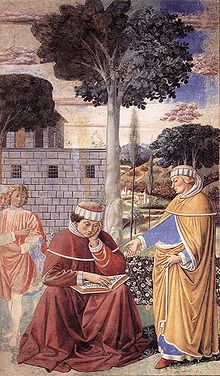Mystical theology
Semi-Autonomous: According to Origen (184/185–253/254AD) and the Alexandrian theology,[3] theoria is the knowledge of God in creation and of sensible things, and thus their contemplation intellectually (150–400AD) (see Clement of Alexandria, and Evagrius Ponticus).
This was to begin with the seminal work Philokalia, which, through hesychasm, leads to Phronema and finally theosis, which is validated by theoria.
[14] Pseudo-Dionysius the Areopagite (5th to early 6th century; writing before 532), himself influenced by the Neoplatonic philosopher Proclus, had a strong impact on Christian thought and practice, both east and west.
In the tradition of Dionysus the Areopagite, theoria is the lifting up of the individual out of time, space and created being, while the Triune God reaches down, or descends, to the hesychast.
St. Gregory Palamas, for example, in referring to these writings, calls the author, "an unerring beholder of divine things".
In western Christianity Dionysius's "via negativa" was particularly influential in the fourteenth and fifteenth centuries, on western mystics such as Marguerite Porete, Meister Eckhart, John Tauler, Jan van Ruusbroec, the author of The Cloud of Unknowing (who made an expanded Middle English translation of Dionysius' Mystical Theology), Jean Gerson, Nicholas of Cusa, Denys the Carthusian, Julian of Norwich and Harphius Herp.
His influence can also be traced in the Spanish Carmelite thought of the sixteenth century among Teresa of Avila and John of the Cross.
"Theologian" was not applied to Symeon in the modern academic sense of theological study; the title was designed only to recognize someone who spoke from personal experience of the vision of God.
[18] A central theme throughout Symeon's teachings and writings is that all Christians should aspire to have actual direct experience of God in deep contemplation, or theoria.
Symeon believed that Christianity had descended into formulae and church ritual, which for many people replaced the earlier emphasis on actual and direct experience of God.
[20] The Discourses express Symeon's strong conviction that the life of a Christian must be much more than mere observance of rules, and must include personal experience of the presence of the living Christ.
Palamas stated that this is not a mechanized process because each person is unique, but that the apodictic way that one experiences the uncreated light, or God, is through contemplative prayer called hesychasm.
Barlaam believed that philosophers had a greater knowledge of God than did the prophets, and valued education and learning more than contemplative prayer.
According to Kalaitzidis, Romanides had a strong influence on contemporary Greek Orthodoxy, to such an extent that some speak about "pre- and post-Romanidian theology.
[27][note 2] Romanides belonged to the "theological generation of the 1960s," which pleaded for a "return to the Fathers," and led to "the acute polarization of the East-West divide and the cultivation of an anti-Western, anti-eucumenical sentiment.
[30] He identified hesychasm as the core of Christian practice[citation needed] and studied extensively the works of 14th-century Byzantine theologian St. Gregory Palamas.
According to Saint Gregory the Great there are people by whom, "while still living in this corruptible flesh, yet growing in incalculable power by a certain piercingness of contemplation, the Eternal Brightness is able to be seen.
"[31] While the direct vision of God (the Beatific Vision) can be reached only in the next life, God does give to some a very special grace, by which he becomes intimately present to the created mind even before death, enabling it to contemplate him with ineffable joy and be mystically united with him even while still alive, true mystical contemplation.
"[36] Contemplative prayer is "a communion in which the Holy Trinity conforms man, the image of God, 'to his likeness'" and in it "the Father strengthens our inner being with power through his Spirit 'that Christ may dwell in (our) hearts through faith' and we may be 'grounded in love' (Ephesians 3:16–17).
"[37] Saint John Cassian the Roman, whose writings influenced the whole of Western monasticism,[38] interpreted the Gospel episode of Martha and Mary as indicating that Jesus declared "the chief good to reside in theoria alone – that is, in divine contemplation", which is initiated by reflecting on a few holy persons and advances to being fed on the beauty and knowledge of God alone.
[39] Saint Augustine has been cited as proving magnificently that man can only find God in the depths of his own soul: "Too late loved I Thee, O Beauty so old, yet ever new!
[41]He is celebrated not only as a contemplative but also as a theologian and Father of the Church, a title given to him in a document of the Fifth Ecumenical Council, held in Constantinople in 553, which declared that it followed his teaching on the true faith "in every way".
[43] Contemplation may sometimes reach a level that has been described as religious ecstasy, and non-essential phenomena, such as visions and stigmata, may sometimes though very rarely accompany it.
[46] The rational exposition and explanation of Christian doctrine is the humbler task of the theologian, while the experience of contemplatives is often of a more lofty level, beyond the power of human words to express,[48] so that "they have had to resort to metaphors, similes, and symbols to convey the inexpressible.



